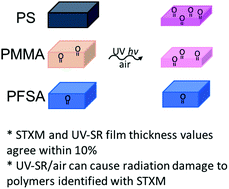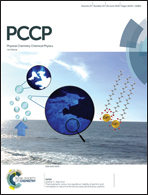Effect of UV radiation damage in air on polymer film thickness, studied by soft X-ray spectromicroscopy†
Abstract
The thicknesses of thin films of polystyrene (PS), poly(methyl methacrylate) (PMMA), and perfluorosulfonic acid (PFSA) were measured by Ultraviolet Spectral Reflectance (UV-SR) and Scanning Transmission X-ray Microscopy (STXM). At high doses, the UV irradiation in air used in the UV-SR method was found to modify the chemical structures of PS and PMMA (but not PFSA), leading to thinning of these polymer films. The chemical changes caused by UV/air radiation damage were characterized by STXM. When UV and X-ray radiation are applied using no-damage conditions, the film thicknesses measured with the two techniques differ by less than 15% for PS and PMMA and less than 5% for PFSA. This is an important result for verifying the quantitation capabilities of STXM. The chemical damage to PS and PMMA is explained by oxygen implantation from air with formation of ozone. The thickness depletion caused by UV/air radiation for PS and PMMA films is exponential with exposure time. Different rates of depletion are linked to surface or bulk driven photo-chemical product erosion. The initial rate of material erosion was found to be constant and non-specific to the studied polymers.



 Please wait while we load your content...
Please wait while we load your content...